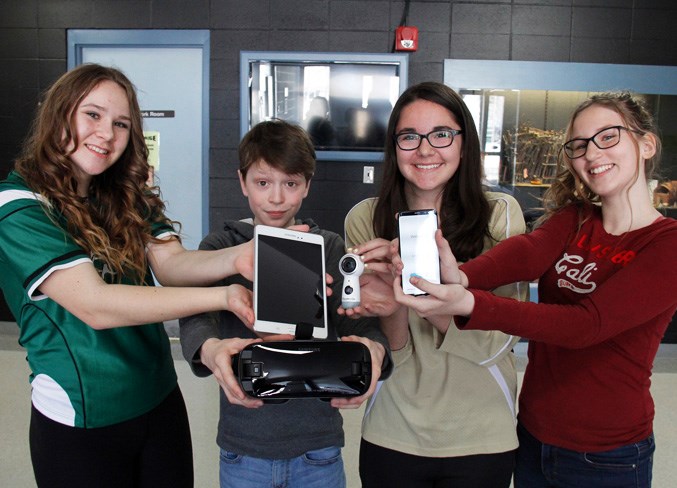Students of H.E. Bourgoin Middle School are stepping up to the Samsung Solve for Tomorrow Challenge.
The small group of students and faculty have landed a place in the top 50 regional finalists for the international competition, which could earn H.E.B. $20,000 in tech-equipment for their school.
This is their second year participating, with Carly Johnson, learning consultant for educational technology for Northern Lights Public Schools (NLPS), leading the way.
For their first shot at the competition, H.E.B. studied the impacts of the regional waterline. This year, they took a more global approach.
“We’re talking about how waste is affecting our oceans and lakes, and looking at focusing on some of the disposable things we use like water bottles,” explained Johnson.
For the four students taking part, the topic hits close to home.
“There’s a lot of waste going into our ecosystem and into the water. It’s affecting the coral reefs in the ocean and our fish, which are very important in our lives. They’re a food source that we need to keep alive. Our water is being contaminated by it, which is a really bad thing, because we also need water to survive,” expressed Grade 8 student J’dyn Thom. “I think this is an important issue that needs to be addressed.”
Johnson suggested the idea to the group because of her personal connection to the topic.
As an avid diver, she sees the impact people have had on the ocean and marine life.
She said, “When I go and see reefs being damaged, it really bugs me. When I go to other countries and see garbage on the shoreline, or even around our lakes, it bothers me. I thought this would be a good topic to focus on.”
Now that the group has pitched their subject and been selected as finalists, they take the equipment provided by Samsung to create a two-minute video.
For Johnson, two minutes isn’t nearly enough time. The students are required to not only explain why their topic is so important, but also to suggest solutions for the problem by using Science, Technology, Environment, and Mathematics (STEM).
For Grade 8 science teacher Tristan Ilko, who is also helping the group, having his students take what they’re learning in the classroom and apply it to real life issues is key.
“STEM is not just about the bits and pieces. It gives them a chance to solve the problem in different ways. It allows them to look at it from the science, technology, environment, and math side of things. It brings everything together on an issue that is bigger than yes or no. It allows the students to look into multiple areas to try and find how they can bring in all of these aspects to find something that may lead to a solution.”
Students are asked to volunteer their time for the project, and for Grade 8 Morganne Baxter, this is her second year participating.
“It was fun to learn about what was happening in the environment and what we can do about it. It was actually cool learning about all of the different lakes last year, how the waterline is going to work, and what’s going to happen,” she said.
Although she has experience with the Solve for Tomorrow Challenge, the topic they’ve chosen is something new.
The group will be spending the next few weeks learning as much as they can about the issue, before creating their video for submission.
“We just started, so we haven’t learned too much, but I feel like we’re going to be learning a lot,” expressed Mackenzie West, Grade 8 participant.
Darah Dahlin is also on the team, and believes making it into the top 50 is a clear sign they have chosen a problem that needs a solution.
This year, the students have less competition. According to Johnson, in 2017 they were up against 150 schools. This time, they only have to beat 18, because the challenge took on more of a regional approach.
Johnson said, “I always like the idea that we’re involving students in more global projects. This school does a lot of it through the WE Movement and the Change Committee. It really gets the kids to realize there are issues outside of their own space.”



